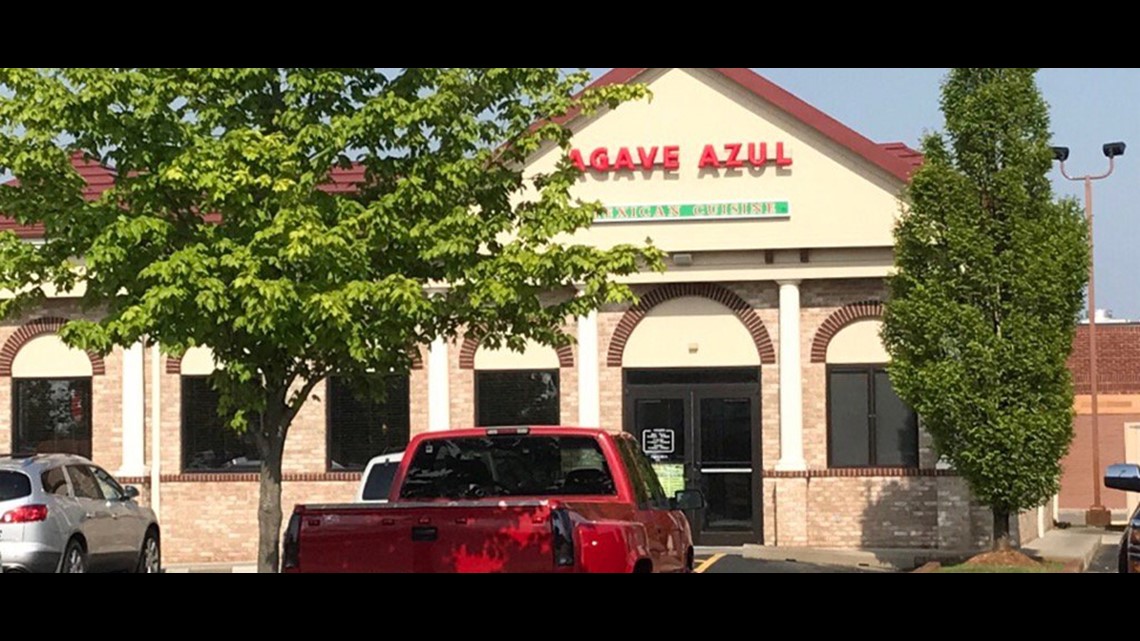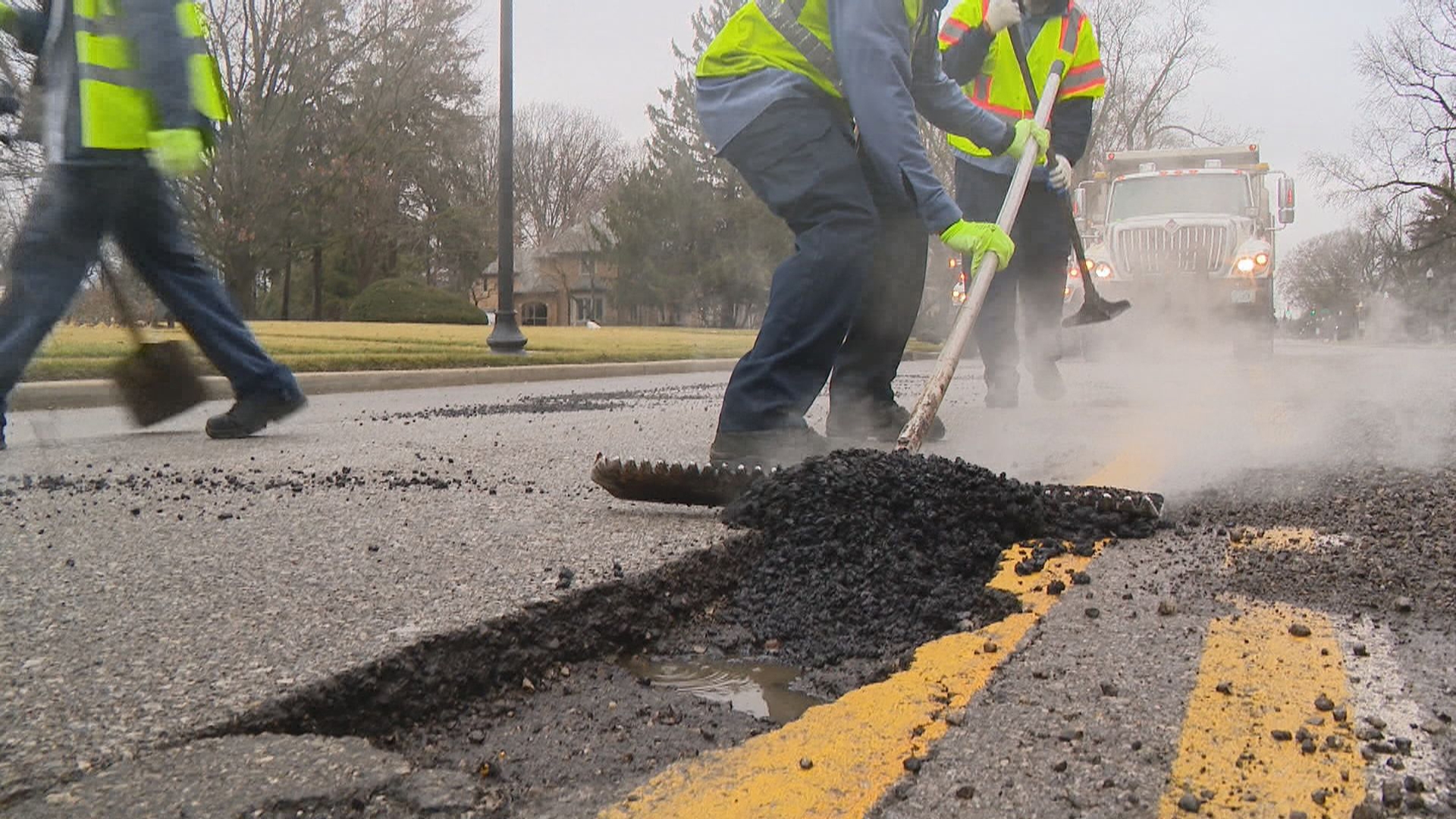

CLARKS HILL, Ind. (WTHR) — Besides for a graying hairline and beard, Alex Zdravich did not look like a typical 66-year-old grandfather. He was in remarkable shape.
"He was a health nut," said his wife Cindy, pointing to weights and exercise equipment in their home gym. "He worked out five days a week. Abs. Legs. Arms. He kept a chart of everything."
Despite his good health, Zdravich was no match for an enchilada, a burrito and a taco at Agave Azul restaurant.
The meal killed him, according to medical experts in Tippecanoe County, who suspected a public health emergency and quickly launched a massive investigation.
"We needed answers," said Craig Rich, administrator at the Tippecanoe County Health Department. "As soon as the death occurred, we called in the state department of health due to the urgency of the situation. We knew something was wrong at the restaurant; we just didn't know for sure what disease or bacteria was making people sick."
The investigation that followed did not play out as inspectors in Tippecanoe County had expected.
Local health officials tell 13 Investigates the case has shaken their confidence in state and federal agencies, triggering serious questions about their ability to protect the public during suspected cases of food poisoning.
"I've never seen anything like it," said county coroner Donna Hart Avolt. "It was very disappointing."
"Had we known this, we'd have done things completely different," added Rich.
And while experts struggled for months to find answers, the restaurant was allowed to remain open and thousands of unsuspecting customers were left in the dark.
His final meal


Cindy Zdravich says her husband was making the most of his retirement. When he wasn't exercising, you'd likely find Alex engaged in one of his many hobbies: gardening in his backyard, repairing vehicles in his custom-built repair shop, sailing on Eagle Creek Reservoir or spending time with his grandchildren.
It was that last activity that brought the Zdravich family to Agave Azul on October 22. Alex and Cindy had just watched their 6-year-old granddaughter play her last soccer game of the season, and they all went to the West Lafayette restaurant for a late lunch.
Alex and Cindy each ordered combo plates with a chicken enchilada, beef burrito and beef taco. Their daughter ordered the same thing, and their son-in-law ordered grilled chicken.
"My granddaughter didn't eat a whole lot other than some rice," recalled Cindy. "Because she was so full on chips and salsa, she didn't eat a bite of anything else. Thank God."
The rest of the day was uneventful.
"We went home and put our leftovers in the fridge and watched the Cubs [win the National League pennant]. It was kind of late when we went to bed," Cindy told WTHR.


A few hours later, around 1:00 am, both Cindy and Alex woke up with severe flu-like symptoms that lasted all night. When those symptoms worsened, Cindy called paramedics to take them to a nearby hospital. Doctors stabilized Cindy by early afternoon, but Alex's condition declined with each passing hour.
"One of the nurses said she had been in the ICU for 20 years and had never seen someone so sick," Cindy said.
At the same time, the couple's daughter also experienced symptoms of food poisoning. She, too, woke up feeling sick at 1:00 am. When an emergency room doctor learned all of them had eaten at the same restaurant the day before, he reported the incident to the Tippecanoe County Health Department.
"I took that phone call, and I thought, 'This could be serious,'" said Rich. "If one person is sick, it's very possible – especially if it's a bacteria – that lots of people are sick. We had to figure out if this was an outbreak."
Within 24 hours, a TCHD inspector was at Agave Azul, asking questions and citing the restaurant for multiple food safety violations. By then, Alex Zdravich was literally fighting for his life. Surgeons removed part of his colon and lower intestine due to infection. He died the following day at the hospital — 99 hours after eating lunch at Agave Azul.
"It's still so surreal," his wife said, looking at their wedding photos. "He was so healthy. I just keeping asking myself, 'Who dies of food poisoning in this day and age?' He just never came home from the hospital."
Finding the killer
As the family prepared for a funeral, the health department intensified its investigation.
"As soon as we learned of the death, I remember calling the [health department's] food service manager and saying, 'We need all hands on deck out at the restaurant,'" Rich told 13 Investigates.
Tippecanoe County health officials wanted to pinpoint the exact cause of the illness to help determine if they needed to warn the public and, perhaps, close the restaurant.
Other customers called the health department to say they got sick eating at the same restaurant on the same day.


On October 27, the day after Zdravich died, TCHD inspectors swarmed Agave Azul. They found 34 health code violations, including 17 "critical violations" involving serious safety problems such as:
- Chicken, beef and salsa stored at improper temperatures
- An employee who handled raw steak and then failed to wash his hands before touching tortillas
- A "green and white fuzzy substance" on peeled garlic cloves in the walk-in refrigerator
- Cleaned utensils soiled with dry food, stored in tubs with an accumulation of dry food
- Raw beef and pork improperly stored above produce and dairy products
Inspectors also collected samples of the food — both from the restaurant and the Agave Azul leftovers the Zdravich family had in their refrigerator — for testing.
The county coroner hoped that testing would provide important answers.
"This is a puzzle we need to solve," she explained. "We could say, 'Oh, yes, it was food poisoning,' but we have to prove it."
To establish that proof — and protect the public — Tippecanoe County asked for help from the Indiana State Department of Health's Rapid Response Team.
State health officials agreed to oversee the testing, so TCHD inspectors hand-delivered the food samples to a state laboratory in Indianapolis.
At the same time, Tippecanoe County's Health Officer convinced the owner of the restaurant to voluntarily close Agave Azul to clean up the many violations identified by health inspectors. They hoped that would give lab technicians the time they needed to identify what had made customers sick.
Rich anxiously waited for the test results.
"I thought it would take a week or two at the most," he said.
"I was expecting the same thing," the coroner added.
"When you have a situation like this with a tragic outcome, everyone wants to complete the investigation as quickly and accurately as possible so we can put out a plan to prevent something like this from happening to someone else," explained Tippecanoe County Health Officer Jeremy Adler. "I was under the impression it would take only a few weeks."
But as fall turned to winter, it became clear answers would not come as quickly as expected.
After a thorough clean-up, the restaurant re-opened less than a week after it shut down. Diners in Tippecanoe County were again eating burritos, enchiladas and tacos at Agave Azul, unaware of the recent outbreak and that health inspectors still had not confirmed the source of the problem.
Following the food
While food samples from Agave Azul were delivered to the Indiana Forensic and Health Sciences Laboratories, the state lab never actually tested the food. It has no capability to test for Clostridium perfringens (C. perf), the dangerous toxin that doctors suspected in Zdravich's death.
"ISDH does not receive a high volume of requests for Clostridium perfringens testing and therefore utilizes other available resources for that testing," ISDH spokeswoman Jeni O'Malley explained to WTHR. "In suspected food-borne illnesses in which the ISDH lab does not have the capability to test for an organism, ISDH's standard protocol is to send samples to the FDA lab or to another state- or university-run lab" to save tax-payer dollars.
That's what the state health department decided to do with the food samples collected from Agave Azul. On October 31, ISDH sent the samples to the U.S. Food and Drug Administration's North Regional Laboratory in Jamaica, New York. The samples arrived three days later, but C. perf testing did not begin right away. It couldn't. That lab does not have the technology to test for Clostridium perfringens, either – important information that ISDH officials now admit they did not realize.
So the FDA then searched for another lab to perform C. perf testing on the food samples it received from Indiana. The agency's Center for Food Safety and Applied Nutrition (CFSAN) in Maryland agreed to take the job. But 13 Investigates has learned scientists at that laboratory were unprepared for the assignment.
"The FDA lab in the Center for Food Safety and Applied Nutrition does not routinely test food samples for outbreak response," explained FDA press officer Peter Cassell. "The national lab conducted the C. perfringens testing but did not have all of the media and reagents necessary for testing available at the time testing was requested, and testing could not proceed until the required media and reagents were available."
Five weeks after local inspectors collected food samples at Agave Azul, the CFSAN lab finally had the supplies and protocols necessary to begin C. perf testing. The lengthy process would take seven more weeks to complete.
That means, three months after a restaurant patron died from simply going out to lunch, most Hoosiers still knew nothing of the tragic mystery at a popular eatery.
Solving the mystery


While the public was kept in the dark during the testing, the Zdravich family was kept in limbo. No test results meant no death certificate.


"Until that death certificate is issued, there are many things the family cannot do," Avolt told WTHR. "They cannot collect on life insurance, Social Security, Social Security benefits. So not just emotionally but also financially, my not issuing the death certificate holds up many, many things for the family."
With few answers from the FDA, local and state inspectors began to look elsewhere.
The state tested stool samples taken from Cindy and Alex Zdravich, and the U.S. Centers for Disease Control tested a portion of Alex's colon that had been surgically removed before he died.
Those results came back by early February, and they all tested positive for C. perf. The coroner found those results convincing enough to complete the death certificate, listing C. perf as Alex Zdravich's official cause of death and Agave Azul as the "place of injury."
Now, state and local health officials were missing just one final piece of information: the FDA lab results for the actual food.
Almost four months after the outbreak of food poisoning first began, the FDA sent those results to the Indiana State Department of Health. To the surprise of local inspectors, the FDA found no C. perf in the restaurant's food samples.
"We thought they were going to come back positive. We heard a long list of excuses or reasons why it could be negative," Rich told WTHR. "The state told us because there was such a long time in transit, it's hard to grow bacteria out of food. Looking back, it was a mistake to send it to the FDA in the first place. We should have sent it to a private lab."
The FDA says that option is always available to local and state health departments, and it was simply trying to assist Indiana based on a request from ISDH.
"While the FDA does monitor and coordinate responses for multi-state outbreaks of foodborne illnesses, the agency does not typically lead investigations at the retail level … FDA did not lead this investigation and was only in a supporting role," Cassell told WTHR.
That role ended February 18, the day the FDA sent its final C. perf test results to the state department of health. With all testing completed and results shared (at least verbally) with the state health department, there was now enough information available for local investigators to fully explain what had been happening at Agave Azul. Yet there was still no information shared with the public. Tippecanoe County health officials say they found themselves bound to secrecy.
Keeping the results a secret
It would take an additional six weeks for the state health department to release its formal investigation report to Tippecanoe County. Local inspectors say the state did not want any information released publicly from Tippecanoe County until ISDH completed its own report.
"All that time, we weren't allowed to say a word while we waited," Rich said. We followed up with the state on a weekly basis, but it just seemed to take quite a while."
E-mails obtained by 13 Investigates show TCHD officials — eager to notify the public about the food poisoning — sent at least four inquiries to the state health department in March and early April.
A March 10 response from the state said a key ISDH staff member had been out of town and "as soon as she gets back to the office she will try to knock it out."
Six days later, Tippecanoe County health officials asked for another update. The state advised "finishing up on this report … expect to receive it soon."
Soon was three weeks later. On April 5, the Indiana State Department of Health released its Agave Azul findings to Tippecanoe County. It also informed TCHD that copies of the state report were not to be released to the public and must be obtained only from ISDH.
WTHR formally requested a copy of that 9-page report. ISDH provided the report to 13 Investigates, but the state agency first redacted the majority of information – leaving several blank sections that had been erased. After WTHR appealed to the Indiana Public Access Counselor, claiming the redactions violated Indiana's Access to Public Records Act, ISDH released more information. Still, large portions of the report were kept secret, including all references to C. perf, the toxin that killed Alex Zdravich and sickened others.
The FDA wanted to keep information about the investigation secret, too. It required Tippecanoe County to sign an agreement to keep all of the test results confidential.


"That really made me mad. I've never run across this in my career," Rich told WTHR. "As soon as they took the samples to test, we had to sign a confidentiality agreement [saying] we would not share them with anyone, despite the fact that they were our samples. We consulted with our attorney, and he had no idea why that would be, but he said 'If you want the results, you better sign.'"
Asked to clarify the reason for the confidentiality agreement, the FDA's press officer provided the federal agency's justification.
"The code of federal regulations expressly prohibits the release of certain information and there are penalties associated with unauthorized disclosure of confidential commercial information or patient information," explained Cassell. "Under existing FDA regulations, the results of all testing conducted by FDA, such as toxicological testing and product testing, are available for public disclosure when the final report is complete and accepted by the responsible FDA official, subject to the deletion of any information that would reveal confidential investigative techniques and procedures."
The Tippecanoe County Health Department eventually got a waiver from the FDA so it could release the results. On April 13 — more than five months after the outbreak at Agave Azul — the local health department released a summary of findings, telling the public about the food poisoning for the very first time.
"TCHD concludes that it is highly likely that the affected individuals contracted Clostridium perfringens through consumption of food prepared at Agave Azul," the report says. "Agave Azul's food handling practices, particularly the consistent practice of holding hot food at inadequate temperatures prior to serving, would promote the growth of pathogens such as Clostridium perfringens."
"Five months. That's too long. It's just way too long. A lot of people ate at that restaurant during that time who might have wanted to know," Rich said. "With that long time delay, we just got lucky. This really could have been a much more tragic situation affecting a lot more people that could have been avoided had we gotten the results sooner."
No apologies
An ISDH spokeswoman told WTHR she disagrees with Rich, saying the state health department does not have the authority to tell local health departments when to release information. She also defended the timing of the state report, based on the CDC's final pathology findings that were not delivered to ISDH until March 13.
"The final results in this investigation were not available until March. When ISDH issues an outbreak report, the agency's protocol is to do so within 60 days of the closure of the investigation. This report was issued well within that timeframe," O'Malley said.
The FDA was unapologetic, too, pointing out "it takes time to order supplies, run samples, analyze results, review lab sheets and verify the results."
But officials in Tippecanoe County still wonder why the state and federal labs are ill-equipped to test food suspected of harboring lethal toxins. They say the recent investigation in Tippecanoe County causes them question the ability of the state and federal government to handle future outbreaks of food poisoning.
"You'd assume the expertise as you go up is better and more efficient, and that's not the case at all," Rich said. "As soon as it went up above us, I feel it kind of got out of control. Communication was the absolute worst, and had we known it would have taken this long, we would have done something — said something — much sooner. When you're dealing with a death, the sooner the better."


The owner of Agave Azul declined to meet with WTHR to discuss the matter, but he did speak via phone about his disappointment with the investigation.
"It is what it is. The health department told us it would be a quick, 2-week process. I don't know why it would take so long," said owner Jose Bustos. Asked about the findings of the state and local health departments that his restaurant was considered the source of the food poisoning, Bustos was indignant.
"If you read the report, it shows they aren't 100% sure where it was from, so I don't know why you'd say it was here," he said. "They called me and said someone got sick and they needed to get samples. Those samples came back negative, and that's all I know. If you read the report, nowhere does it say that it was from our restaurant."
Told that the coroner's death certificate clearly states the name of his restaurant as the place of the fatal injury, Bustos quickly ended the conversation and hung up.
"I'm very certain — very certain — that this death was caused by food eaten at that restaurant," Avolt told WTHR. "Otherwise, I wouldn't have put it on the death certificate."
"Yes, doing a full epidemiological investigation concludes that it came from the restaurant," Rich said, emphasizing the lack of positive C. perf test results for the food samples likely resulted from delays in testing.
Since the outbreak, the health department has placed Agave Azul on a more stringent inspection schedule. Rich believes the restaurant has made significant improvements through training and improved food handling. "Right now, there is not an unreasonable risk eating there as opposed to any other restaurant," he said. "It's not something we even think about, but eating can be dangerous."
"I guess we've all been kind of naïve when it comes to food poisoning," said Cindy Zdravich. "You have a certain trust that restaurants are doing what they're supposed to, and I think most of them are. But when things do happen, there are agencies and people who are supposed to be on top of these things, and now we find out that's not the case. There's some real glitches in the system, and I hope this stuff gets fixed."



